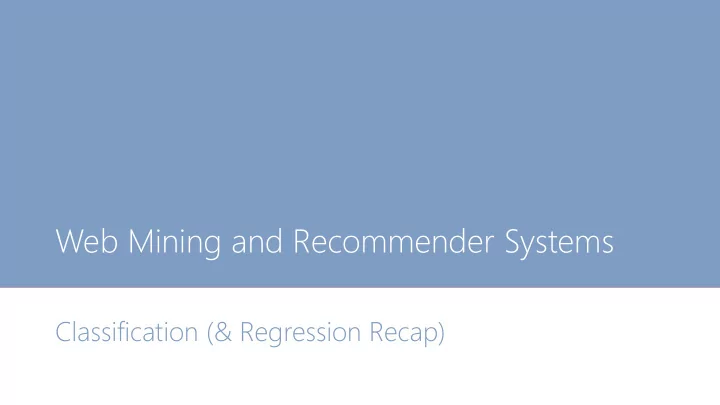

SVMs vs Logistic regression • Logistic regressors don’t optimize the number of “mistakes” • No special attention is paid to the “difficult” instances – every instance influences the model • But “easy” instances can affect the model (and in a bad way!) • How can we develop a classifier that optimizes the number of mislabeled examples?
Support Vector Machines: Basic idea A classifier can be defined by the hyperplane (line)
Support Vector Machines: Basic idea Observation: Not all classifiers are equally good
Support Vector Machines An SVM seeks the classifier • (in this case a line) that is furthest from the nearest points This can be written in terms • of a specific optimization problem: such that “support vectors”
Support Vector Machines But : is finding such a separating hyperplane even possible?
Support Vector Machines Or : is it actually a good idea?
Support Vector Machines Want the margin to be as wide as possible While penalizing points on the wrong side of it
Support Vector Machines Soft-margin formulation: such that
Summary of Support Vector Machines SVMs seek to find a hyperplane (in two • dimensions, a line) that optimally separates two classes of points The “best” classifier is the one that classifies all • points correctly, such that the nearest points are as far as possible from the boundary If not all points can be correctly classified, a • penalty is incurred that is proportional to how badly the points are misclassified (i.e., their distance from this hyperplane)
Learning Outcomes • Introduced a different type of classifier that seeks to minimize the number of mistakes made more directly
Web Mining and Recommender Systems Classification – Worked example
Learning Goals • Work through a simple example of classification • Introduce some of the difficulties in evaluating classifiers
Judging a book by its cover [0.723845, 0.153926, 0.757238, 0.983643, … ] 4096-dimensional image features Images features are available for each book on http://cseweb.ucsd.edu/classes/fa19/cse258-a/data/book_images_5000.json http://caffe.berkeleyvision.org/
Judging a book by its cover Example: train a classifier to predict whether a book is a children’s book from its cover art (code available on course webpage)
Judging a book by its cover The number of errors we • made was extremely low, yet our classifier doesn’t seem to be very good – why? (stay tuned!)
Web Mining and Recommender Systems Classifiers: Summary
Learning Goals • Summarize some of the differences between each of the classification schemes we have seen
Previously… How can we predict binary or categorical variables? {0,1}, {True, False} {1, … , N}
Previously… Will I purchase this product? (yes) Will I click on this ad? (no)
Previously… Naïve Bayes • • Probabilistic model (fits ) • Makes a conditional independence assumption of the form allowing us to define the model by computing for each feature • Simple to compute just by counting Logistic Regression • • Fixes the “double counting” problem present in naïve Bayes SVMs • • Non-probabilistic: optimizes the classification error rather than the likelihood
1) Naïve Bayes posterior prior likelihood evidence due to our conditional independence assumption:
2) logistic regression sigmoid function: Classification boundary
Logistic regression Q: Where would a logistic regressor place the decision boundary for these features? positive negative examples examples a b
Logistic regression Q: Where would a logistic regressor place the decision boundary for these features? positive negative examples examples hard to classify b easy to easy to classify classify
Logistic regression Logistic regressors don’t optimize the • number of “mistakes” No special attention is paid to the “difficult” • instances – every instance influences the model But “easy” instances can affect the model • (and in a bad way!) How can we develop a classifier that • optimizes the number of mislabeled examples?
3) Support Vector Machines Can we train a classifier that optimizes the number of mistakes, rather than maximizing a probability? Want the margin to be as wide as possible While penalizing points on the wrong side of it
Pros/cons Naïve Bayes • ++ Easiest to implement, most efficient to “train” ++ If we have a process that generates feature that are independent given the label, it’s a very sensible idea -- Otherwise it suffers from a “double - counting” issue Logistic Regression • ++ Fixes the “double counting” problem present in naïve Bayes -- More expensive to train SVMs • ++ Non-probabilistic: optimizes the classification error rather than the likelihood -- More expensive to train
Summary Naïve Bayes • • Probabilistic model (fits ) • Makes a conditional independence assumption of the form allowing us to define the model by computing for each feature • Simple to compute just by counting Logistic Regression • • Fixes the “double counting” problem present in naïve Bayes SVMs • • Non-probabilistic: optimizes the classification error rather than the likelihood
Web Mining and Recommender Systems Evaluating classifiers
Learning Goals • Discuss several schemes for evaluating classifiers under different conditions
Which of these classifiers is best? a b
Which of these classifiers is best? The solution which minimizes the #errors may not be the best one
Which of these classifiers is best? 1. When data are highly imbalanced If there are far fewer positive examples than negative examples we may want to assign additional weight to negative instances (or vice versa) e.g. will I purchase a product? If I purchase 0.00001% of products, then a classifier which just predicts “no” everywhere is 99.99999% accurate, but not very useful
Which of these classifiers is best? 2. When mistakes are more costly in one direction False positives are nuisances but false negatives are disastrous (or vice versa) e.g. which of these bags contains a weapon?
Which of these classifiers is best? 3. When we only care about the “most confident” predictions e.g. does a relevant result appear among the first page of results?
Evaluating classifiers decision boundary negative positive
Evaluating classifiers decision boundary negative positive TP (true positive): Labeled as positive, predicted as positive
Recommend
More recommend